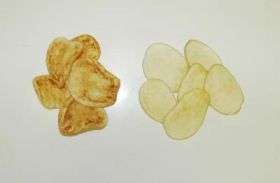People only eat 1 when the chips are brown

Dr. Don Henne isn't wasting his degree when he's standing by the deep fryer waiting for potato slices to turn brown. He's conducting research that will help the potato industry and consumers.
Henne, an assistant research scientist in the Texas AgriLife Research plant pathology program in Amarillo, is one of many who are trying to find answers about zebra chip. Zebra chip is the latest disease to plague the potato industry, especially those in the chipping business.
Dr. Charlie Rush, AgriLife Research plant pathologist and leader of the program, began working on the project at the request of local producers in early 2007. His work later became a part of the Zebra Chip State Initiative through the Texas Department of Agriculture.
The initiative brought together researchers from throughout the state and country to try to find answers for zebra chip, Rush said.
"When we first began working on it, the pathogen and vector were unknown," he said. "Only recently have researchers began pinning those down."
Rush said Henne was brought into the program in May because of his experience and background. His primary responsibility is to help understand the factors that impact disease onset and spread. Zebra chip is a disease that alters the sugar levels in the potato, Henne said. The sugar caramelizes and turns the chip brown when it is fried, giving it an off taste and burnt appearance. While it is not harmful, it is a cosmetic and taste concern for consumers.
Potato growers have had to abandon entire infected fields, costing as much as $2 million a year in damage, he said.
Henne, who has a degree in entomology, is trying to chase the potato psyllid, the insect that likely carries the pathogens which cause the disease. He is trying to find out what makes it move through a field, as well as when it moves and how fast.
He has visited grower fields from Weslaco to Pearsall and Olton to Dalhart already this year, as well as made contact with other zebra chip researchers around the nation to familiarize himself with this new chipping potato disease.
Zebra chip first appeared in Mexico and Guatemala in the early 2000s. It has been found in potato fields through South Texas and the Rio Grande Valley and now up into the South Plains and Panhandle regions.
The disease presents itself as curled leaves and stunted growth in the plant itself, and then the tubers exhibit a brown striped or mottled pattern when sliced, Henne said.
AgriLife Research and other scientists around the country have studied the vector or insect that transmits the pathogen, he said. Others are trying to identify the pathogen or bacteria that actually causes disease in the plant when the psyllid feeds on it.
Henne and other Amarillo-based researchers are working with commercial growers to monitor the movement of the insect and disease appearance. At the same time, they have established potato plots at the Texas AgriLife Research Station at Bushland and are doing some greenhouse work.
"We're focusing on the epidemiological aspects of the disease," Henne said. "We are trying to understand how the disease progresses in a potato field over time. We are looking at canopy structure, edge effect and how the insects are landing in fields and distributing the disease."
Henne and Dr. Fekede Workneh, an AgriLife Research quantitative plant disease epidemiologist, have planted six acres of potatoes at the Bushland station where they are looking at planting dates, canopy structure and insect dispersal.
Potatoes are planted in late March to early June in the Panhandle, so they are experimenting with planting dates – May 2, May 28 and June 16 – at Bushland to see if there is a relation between insect movement and disease severity.
"We are also working in the lab to graft diseased portions onto healthy plants to understand the movement of the disease through the plant," Henne said.
"We want to understand how the disease progresses so we can focus management practices on specific areas," he said. "Do the insects move up the plant, down or out from the stem? Some varieties have more canopy than others and is that acting as a natural bridge for insect movement?"
There is no adequate control for the insect or the disease at this time, he said.
Because there are other diseases that have similar symptoms as zebra chip, Henne said, one of the challenges they face is being able to correctly identify diseased plants in the field.
"When we find plants that appear to be infected, we bring the tubers back to the lab where they are sliced and fried to make the final determination," he said.
Henne said they hoped to have some management suggestions on how to help alleviate the problem for growers by the end of this year.
Source: Texas A&M University



















